Proposed Framework for the Flood Disaster Management Cycle in Malaysia
Abstract
:1. Introduction
- What are the recent flood disasters reported in the study area?
- What are the key current challenges the stakeholders are facing to manage the flood disasters?
- What can the possible suitable remedial measure to improve flood disaster management?
2. Literature Review
3. Stages of Flood Disaster Management
4. Research Methodology
5. Case Study Area
6. Impact of Flood Disaster in Sarawak
7. Challenges Faced in Managing Flood Disaster
8. Flood Disaster Mitigations
9. Interviews with Experts
10. Key Findings
11. Framework
12. Conclusions
Author Contributions
Funding
Institutional Review Board Statement
Informed Consent Statement
Data Availability Statement
Acknowledgments
Conflicts of Interest
References
- Yazdani, M.; Mojtahedi, M.; Loosemore, M.; Sanderson, D. A modelling framework to design an evacuation support system for healthcare infrastructures in response to major flood events. Prog. Disaster Sci. 2022, 13, 100218. [Google Scholar] [CrossRef]
- Keating, J.A.; Campbell, K.; Mechler, R.; Michel-Kerjan, E.; Mochizuki, L.S.K.; Kunreuther, H.; Bayer, J.; Hanger, S.; McCallum, I.; Williges, C.; et al. Operationalizing Resilience Against Natural Disaster Risk: Opportunities, Barriers and A Way forward. Zurich Insur. IIASA Whart 2014, 1–73. Available online: http://www.iiasa.ac.at/web/home/research/researchPrograms/RiskPolicyandVulnerability/whitepaper.pdf (accessed on 10 January 2022).
- OECD. Financial Management of Flood Risk; OECD: Paris, France, 2016. [Google Scholar] [CrossRef]
- Below, R.; Wallemacq, P. Centre for Research on the Epidemiology of Disasters. Annu. Disaster Stat. Rev. 2018. Available online: https://www.cred.be/search/node/world disaster statistics for affected people (accessed on 10 January 2022).
- Flooding Could Worsen Impacts of COVID-19 and Other Infectious Diseases; World Resources Institute: Washington, DC, USA, 2020; Available online: https://www.wri.org/news/release-new-data-shows-millions-people-trillions-property-risk-flooding-infrastructure (accessed on 12 February 2022).
- Our World in Data. Research and Data to Make Progress against the World’s Largest Problems. 2021. Available online: https://ourworldindata.org/%0Ahttp://files/11321/ourworldindata.org.html (accessed on 11 February 2022).
- Sa’adi, Z.; Shahid, S.; Ismail, T.; Chung, E.S.; Wang, X.J. Distributional changes in rainfall and river flow in Sarawak, Malaysia. Asia-Pac. J. Atmos. Sci. 2017, 53, 489–500. [Google Scholar] [CrossRef]
- IDMC. Global Report on Internal Displacement; Internal Displacement Monitoring Centre: Geneva, Switzerland, 2021; Available online: https://www.internal-displacement.org/global-report/grid2017/ (accessed on 14 February 2022).
- Our World in Data. SDG Tracker. In Measuring Progress towards the Sustainable Development Goals. 2019. Available online: https://sdg-tracker.org/UK (accessed on 21 January 2022).
- Flanagan, B.E.; Gregory, E.W.; Hallisey, E.J.; Heitgerd, J.L.; Lewis, B. A Social Vulnerability Index for Disaster Management. J. Homel. Secur. Emerg. Manag. 2011, 8, 1–24. [Google Scholar] [CrossRef]
- Siddiqui, F.; Akhund, M.A.; Ali, T.H.; Khahro, S.H.; Khoso, A.R.; Imad, H.U. Barriers in Adoption of Building Information Modeling in Pakistans Construction Industry. Indian J. Sci. Technol. 2019, 12, 1–7. [Google Scholar] [CrossRef]
- Riboldi, I. Integrated Flood Management (IFM): A new approach to flood management. Aid. Int. Dev. Forum. 2014. Available online: http://www.aidforum.org/topics/water-sanitation/integrated-flood-management-ifm-a-new-approach-to-flood-management/ (accessed on 23 January 2022).
- Ismail, M.S.N.; Ghani, A.N.A.; Ghazaly, Z.M. The characteristics of road inundation during flooding events in peninsular Malaysia. Int. J. Geomate 2019, 16, 129–133. [Google Scholar] [CrossRef]
- Petrucci, O.; Aceto, L.; Bianchi, C.; Bigot, V.; Brázdil, R.; Pereira, S.; Kahraman, A.; Kılıç, Ö.; Kotroni, V.; Llasat, M.C.; et al. Features, and Lessons to Learn. 2019. Available online: https://www.mdpi.com/2073-4441/11/8/1682 (accessed on 11 February 2022).
- Asian Development Bank. Reducing Disaster Risk by Managing Urban Land Use: Guidance Notes for Planners; Asian Development Bank: Mandaluyong, Philippines, 2016. [Google Scholar]
- Jamaludin, I.S.; Sulaiman, N. Malaysia resilient initiatives: Case study of melaka into resilient city. Plan. Malays. 2018, 16, 15–24. [Google Scholar] [CrossRef]
- Shah, A.A.; Ye, J.; Abid, M.; Khan, J.; Amir, S.M. Flood hazards: Household vulnerability and resilience in disaster-prone districts of Khyber Pakhtunkhwa province, Pakistan. Nat. Hazards 2018, 93, 147–165. [Google Scholar] [CrossRef]
- Yusoff, I.M.; Ramli, A.; Alkasirah, N.A.M.; Nasir, N.M. Exploring the managing of flood disaster: A Malaysian perspective. Malaysian J. Soc. Sp. 2018, 14, 24–36. [Google Scholar] [CrossRef]
- Shafiai, S.; Khalid, M.S. Examining of issues on flood disaster management in Malaysia. Int. Rev. Manag. Mark. 2016, 6, 51–56. [Google Scholar]
- Official Website of Department of Irrigation and Drainage Sarawak. 2019. Available online: https://did.sarawak.gov.my/ (accessed on 2 February 2022).
- Sarawak Government. The Official Portal of Sarawak Government; Sarawak Government: Sarawak, Malaysia, 2020.
- Sa’adi, Z.; Shahid, S.; Ismail, T.; Chung, E.S.; Wang, X.J. Trends analysis of rainfall and rainfall extremes in Sarawak, Malaysia using modified Mann–Kendall test. Meteorol. Atmos. Phys. 2019, 131, 263–277. [Google Scholar] [CrossRef]
- Busayo, E.T.; Kalumba, A.M.; Afuye, G.A.; Olusola, A.O.; Ololade, O.O.; Orimoloye, I.R. Rediscovering South Africa: Flood disaster risk management through ecosystem-based adaptation. Environ. Sustain. Indic. 2022, 14, 100175. [Google Scholar] [CrossRef]
- Busayo, E.T.; Kalumba, A.M. Recommendations for linking climate change adaptation and disaster risk reduction in urban coastal zones: Lessons from East London, South Africa. Ocean Coast. Manag. 2021, 203, 105454. [Google Scholar] [CrossRef]
- Chai, S.S.; Wong, W.K.; Goh, K.L. Rainfall Classification for Flood Prediction Using Meteorology Data of Kuching, Sarawak, Malaysia: Backpropagation vs Radial Basis Function Neural Network. Int. J. Environ. Sci. Dev. 2017, 8, 385–388. [Google Scholar] [CrossRef] [Green Version]
- Alamgir, M.; Campbell, M.J.; Sloan, S.; Engert, J.; Word, J.; Laurance, W.F. Emerging challenges for sustainable development and forest conservation in Sarawak, Borneo. PLoS ONE 2020, 15, 1–20. [Google Scholar] [CrossRef] [Green Version]
- Mohammed, N.; Edwards, R.; Gale, A. Optimisation of Flooding Recovery for Malaysian Universities. Procedia Eng. 2018, 212, 356–362. [Google Scholar] [CrossRef]
- FEMA. Emergency Management in the United States—What Are Four Phases of Emergency; FEMA: Washington, DC, USA, 2020; pp. 1–16.
- Federal Emergency Management Agency. Mitigation Recovery Preparedness Response; Federal Emergency Management Agency: Washington, DC, USA, 2017.
- Osti, R.P.; Asian Development Bank. Strengthening Flood Risk Management Policy and Practice in the People’s Republic of China. 2017. Available online: https://www.adb.org/sites/default/files/publication/391621/eawp-011.pdf (accessed on 17 January 2022).
- Abid, S.K.; Sulaiman, N.; Mahmud, N.P.N.; Nazir, U.; Adnan, N.A. A review on the application of remote sensing and geographic information system in flood crisis management. J. Crit. Rev. 2020, 7, 491–496. [Google Scholar] [CrossRef]
- Noorhashirin, H.; Juni, M.H. Assessing malaysian disaster preparedness for flood. Int. J. Public Health Clin. Sci. 2016, 3, 1–15. [Google Scholar]
- Chong, N.O.; Kamarudin, K.H. Disaster risk management in Malaysia: Issues and challenges from the persepctive of agencies. Plan. Malays. 2018, 16, 105–117. [Google Scholar] [CrossRef]
- Räsänen, A.; Lein, H.; Bird, D.; Setten, G. Conceptualizing community in disaster risk management. Int. J. Disaster Risk Reduct. 2020, 45, 101485. [Google Scholar] [CrossRef]
- Sarawak. Category: Sarawak. Wikimedia Commons. 2022. Available online: https://commons.wikimedia.org/wiki/Category:Sarawak (accessed on 2 February 2022).
- Rollason, E.; Bracken, L.J.; Hardy, R.J.; Large, A.R.G. Rethinking flood risk communication. Nat. Hazards 2018, 92, 1665–1686. [Google Scholar] [CrossRef] [Green Version]
- Talpur, M.A.H.; Napiah, M.; Chandio, I.A.; Qureshi, T.A.; Khahro, S.H. Development of a regional transport policy support system for rural planning agencies in developing world. Procedia Eng. 2014, 77, 2–10. [Google Scholar] [CrossRef] [Green Version]
- Botzen, W.J.W.; Deschenes, O.; Sanders, M. The economic impacts of natural disasters: A review of models and empirical studies. Rev. Environ. Econ. Policy 2019, 13, 167–188. [Google Scholar] [CrossRef] [Green Version]
- Bubeck, P.; Otto, A.; Weichselgartner, J.; Bubeck, P.; Otto, A.; Weichselgartner, J. Societal Impacts of Flood Hazards. Oxford Res. Encycl. Nat. Hazard Sci. 2017. [Google Scholar] [CrossRef]
- Busayo, E.T.; Kalumba, A.M. Coastal climate change adaptation and disaster risk reduction: A review of policy, programme and practice for sustainable planning outcomes. Sustainability 2020, 12, 6450. [Google Scholar] [CrossRef]
- Yazid, A.S.; Adnan, T.F.F.T.; Abdullah, A.A.; Daud, W.N.W.; Salleh, F.; Husin, M.R. Flood Risk Mitigation: Pressing Issues and Challenges. Int. Rev. Manag. Mark. 2017, 7, 157–163. [Google Scholar]
- Al-Dahash, H.; Kulatunga, U.; Al-Dahash, H.; Thayaparan, M.; Kulatunga, U. Challenges during Disaster Response Planning Resulting from War Operations and Terrorism in Iraq. In Proceedings of the 12th International conference of the International Institute for Infrastructure Resilience and Reconstruction, Kandy, Sri Lanka, 5–7 August 2016. [Google Scholar]
- Rubinato, M.; Nichols, A.; Peng, Y.; Zhang, J.M.; Lashford, C.; Cai, Y.P.; Lin, P.Z.; Tait, S. Urban and river flooding: Comparison of flood risk management approaches in the UK and China and an assessment of future knowledge needs. Water Sci. Eng. 2019, 12, 274–283. [Google Scholar] [CrossRef]
- Shah, M.A.R.; Rahman, A.; Chowdhury, S.H. Challenges for achieving sustainable flood risk management. J. Flood Risk Manag. 2018, 11, S352–S358. [Google Scholar] [CrossRef] [Green Version]
- Mabahwi, N.A.; Nakamura, H. The Issues and Challenges of Flood-related Agencies in Malaysia. Environ. Proc. J. 2020, 5, 285–290. [Google Scholar] [CrossRef]
- Ali, M.H.; Bhattacharya, B.; Islam, A.K.M.S.; Islam, G.M.T.; Hossain, M.S.; Khan, A.S. Challenges for flood risk management in flood-prone Sirajganj region of Bangladesh. J. Flood Risk Manag. 2019, 12, 1–12. [Google Scholar] [CrossRef] [Green Version]
- See, K.L.; Nayan, N.; Rahaman, Z.A. Flood Disaster Water Supply: A Review of Issues and Challenges in Malaysia. Int. J. Acad. Res. Bus. Soc. Sci. 2017, 7, 525–532. [Google Scholar] [CrossRef] [Green Version]
- Waylen, K.A.; Holstead, K.L.; Colley, K.; Hopkins, J. Challenges to enabling and implementing Natural Flood Management in Scotland. J. Flood Risk Manag. 2018, 11, S1078–S1089. [Google Scholar] [CrossRef] [Green Version]
- Nurashikin, M.; Rodger, E.; Rumaizah, M.N. Reducing Flooding Impacts to the Built Environment: A Literature Review. MATEC Web Conf. 2019, 266, 02001. [Google Scholar] [CrossRef]
- Ramanuja, N. Challenges in Disaster Management. DHARANA Bhavan’s Int. J. Bus. 2015, 9, 5–16. [Google Scholar]
- Khalid, M.S.B.; Shafiai, S.B. Flood Disaster Management in Malaysia: An Evaluation of the Effectiveness Flood Delivery System. Int. J. Soc. Sci. Humanit. 2015, 5, 398–402. [Google Scholar] [CrossRef] [Green Version]
- Yang, T.H.; Liu, W.C. A general overview of the risk-reduction strategies for floods and droughts. Sustainability 2020, 12, 2687. [Google Scholar] [CrossRef] [Green Version]
- Hapsari, R.I.; Zenurianto, M. View of Flood Disaster Management in Indonesia and the Key Solutions American Journal of Engineering Research (AJER). Am. J. Eng. Res. 2016, 5, 140–151. [Google Scholar]
- Rehman, J.; Sohaib, O.; Asif, M.; Pradhan, B. Applying systems thinking to flood disaster management for a sustainable development. Int. J. Disaster Risk Reduct. 2019, 36, 101101. [Google Scholar] [CrossRef]
- Raikes, J.; Smith, T.F.; Jacobson, C.; Baldwin, C. Pre-disaster planning and preparedness for floods and droughts: A systematic review. Int. J. Disaster Risk Reduct. 2019, 38, 101207. [Google Scholar] [CrossRef]
- Ogie, R.I.; Adam, C.; Perez, P. A review of structural approach to flood management in coastal megacities of developing nations: Current research and future directions. J. Environ. Plan. Manag. 2020, 63, 127–147. [Google Scholar] [CrossRef]
- Sulaiman, N.; She, T.W.; Fernando, T.; WeiChan, S.; Roslan, A.F.; Latib, S.K. Multi-Agency Collaboration in Flood Disaster Management in Sarawak, Malaysia. Int. J. Innov. Technol. Explor. Eng. 2019, 8, 411–419. [Google Scholar]
- Jongman, B. Effective adaptation to rising flood risk. Nat. Commun. 2018, 9, 9–11. [Google Scholar] [CrossRef] [Green Version]
- Mansor, N. Managing flood problems. New Straint Times. 22 October 2019. Available online: https://www.nst.com.my/opinion/columnists/2019/10/532457/managing-flood-problems (accessed on 19 January 2022).
- Sim, D. New approach in overcoming flash flooding in Sarawak. Borneo Post Online, 17 July 2018. [Google Scholar]
- Povera, A. Flood risk in parts of Sarawak. New Strait Times. 13 November 2017. Available online: https://www.nst.com.my/news/nation/2017/11/302927/flood-risk-parts-sarawak (accessed on 12 February 2022).
- Fidelis, G.D. Challenges of Poor Drainage Systems in Lagos Metropolis Challenges of Poor Drainage Systems in Lagos Metropolis. Doctoral Dissertation, University of Port Harcourt, Port Harcourt, Nigeria, 2019. [Google Scholar] [CrossRef]
- Lyu, H.M.; Xu, Y.S.; Cheng, W.C.; Arulrajah, A. Flooding hazards across Southern China and prospective sustainability measures. Sustainability 2018, 10, 1682. [Google Scholar] [CrossRef] [Green Version]
- Kulatunga, U.; Pathirage, C.; Thayaparan, M.; Sulaiman, N. Vulnerability Assessment for Climate—Induced Disasters in Malaysia. 2016. Available online: https://openresearch.lsbu.ac.uk/item/87112 (accessed on 31 January 2022).
- Bahadori, M.; Khankeh, H.R.; Zaboli, R.; Malmir, I. Coordination in Disaster: A Narrative Review. Int. J. Med. Rev. 2015, 2, 273–281. [Google Scholar]
- Shah, A.A.; Shaw, R.; Ye, J.; Abid, M.; Amir, S.M.; Pervez, A.K.; Naz, S. Current capacities, preparedness and needs of local institutions in dealing with disaster risk reduction in Khyber Pakhtunkhwa, Pakistan. Int. J. Disaster Risk Reduct. 2019, 34, 165–172. [Google Scholar] [CrossRef]
- Schanze, J. Nature-based solutions in flood risk management—Buzzword or innovation? J. Flood Risk Manag. 2017, 10, 281–282. [Google Scholar] [CrossRef]
- Maskrey, S.A.; Mount, N.J.; Thorne, C.R. Doing flood risk modelling differently: Evaluating the potential for participatory techniques to broaden flood risk management decision-making. J. Flood Risk Manag. 2022, 15, 12757. [Google Scholar] [CrossRef]
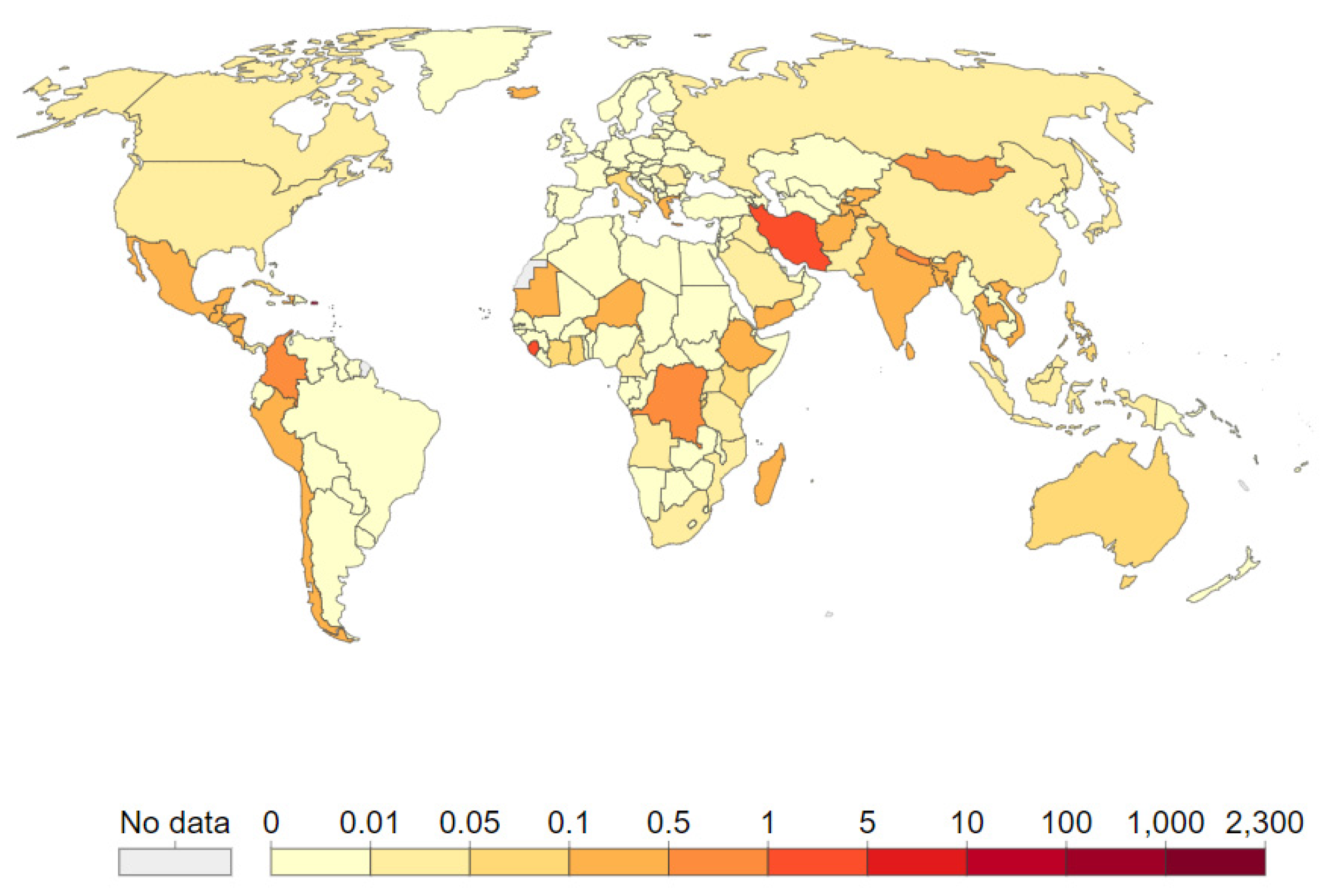



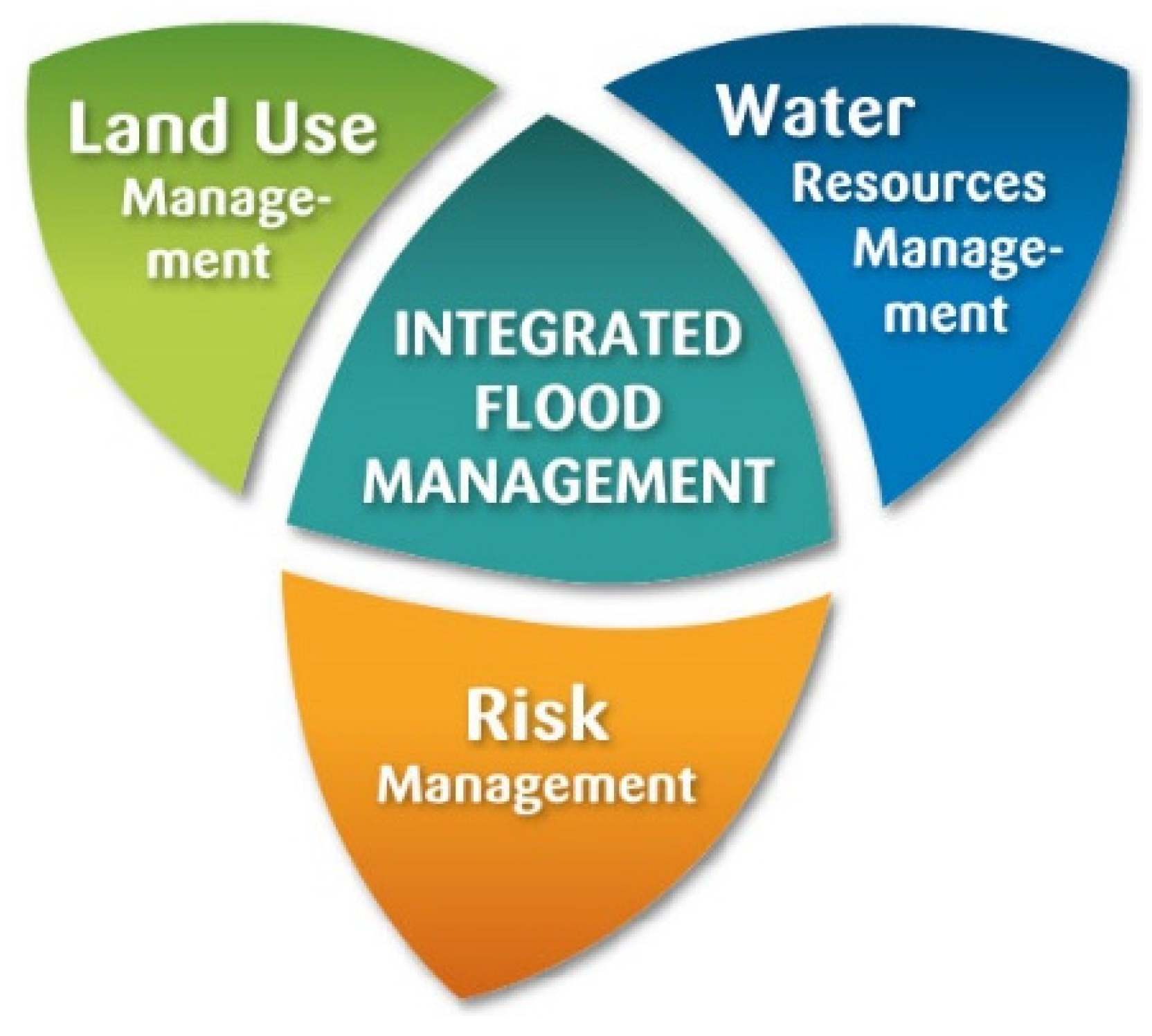


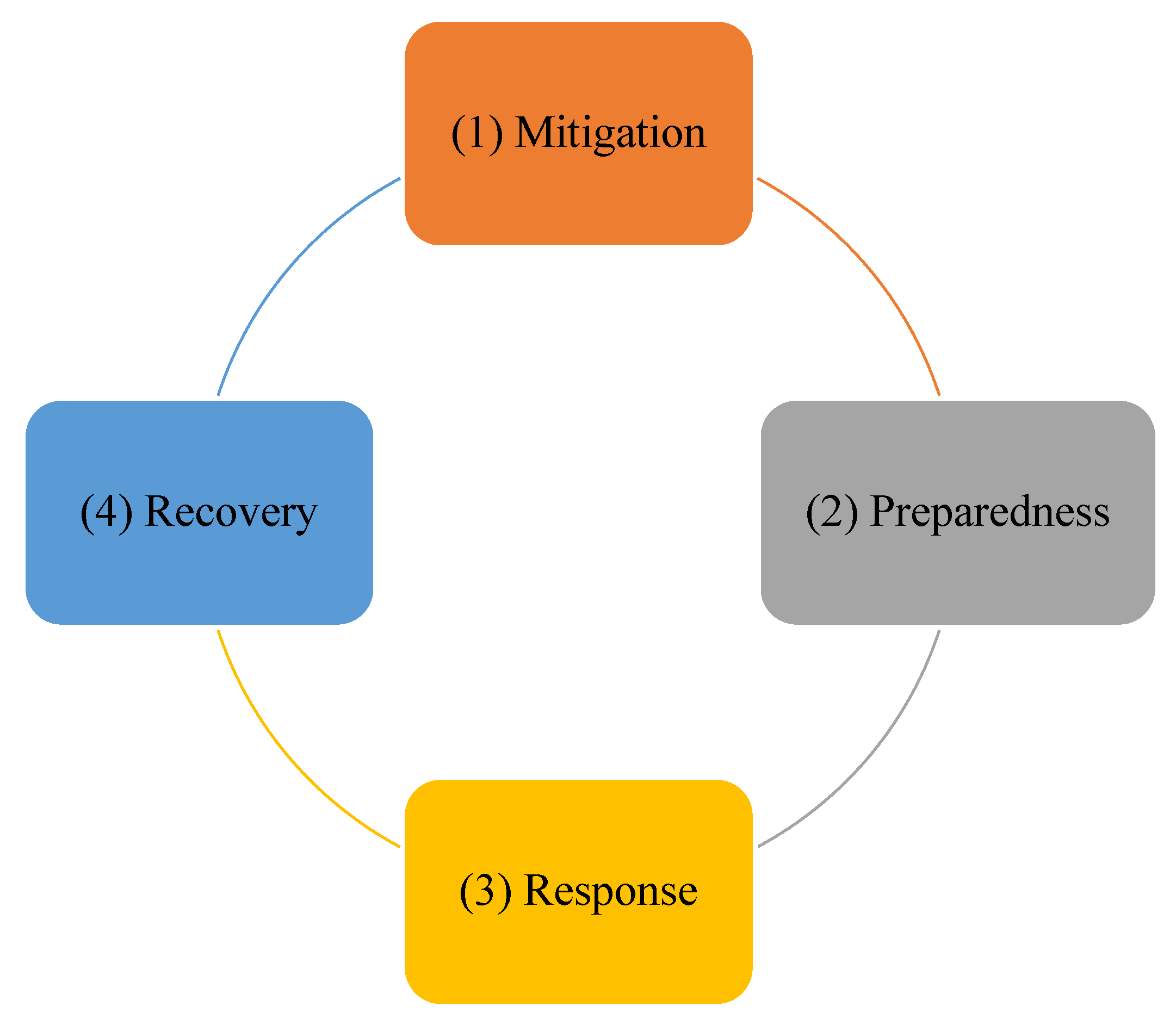
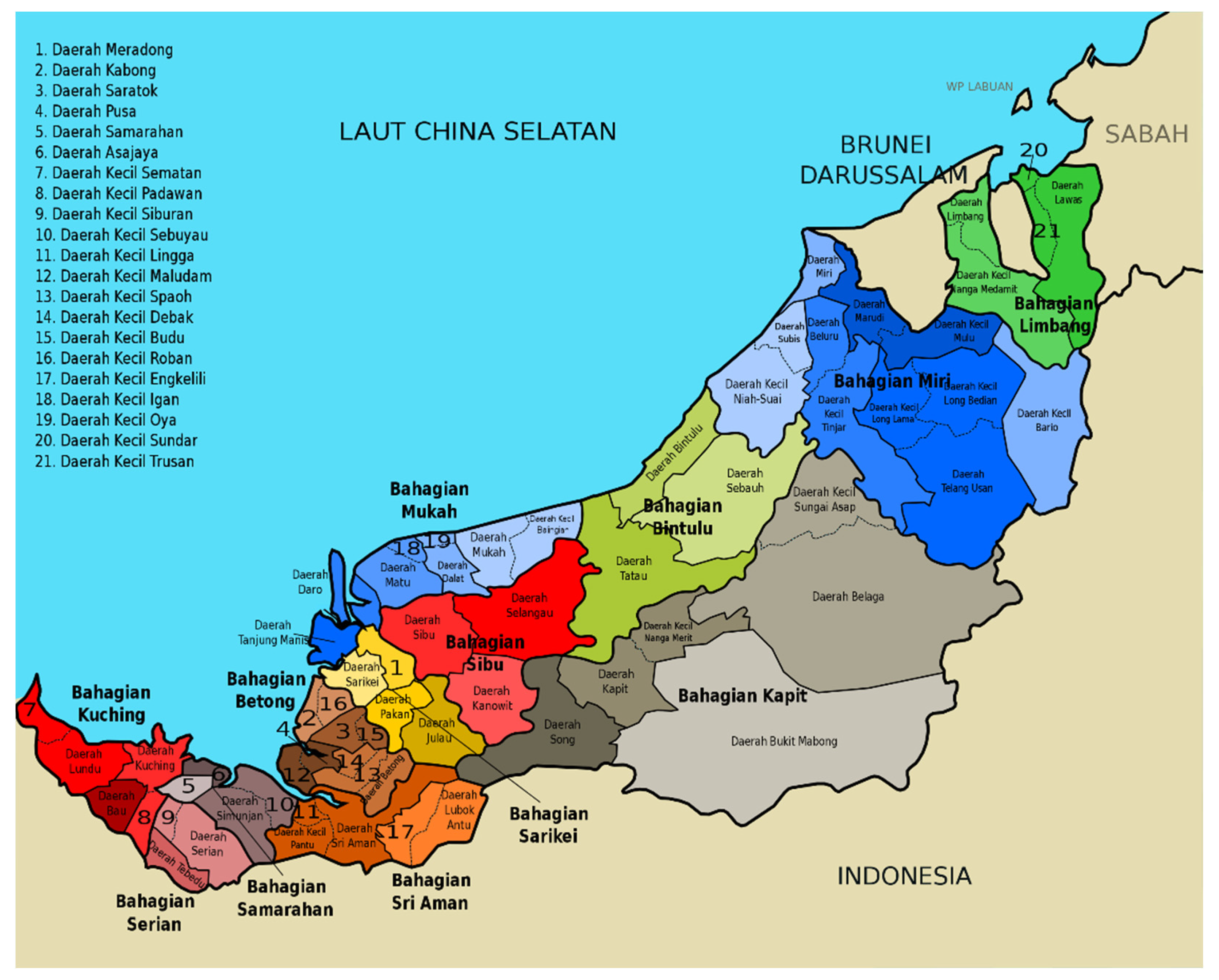
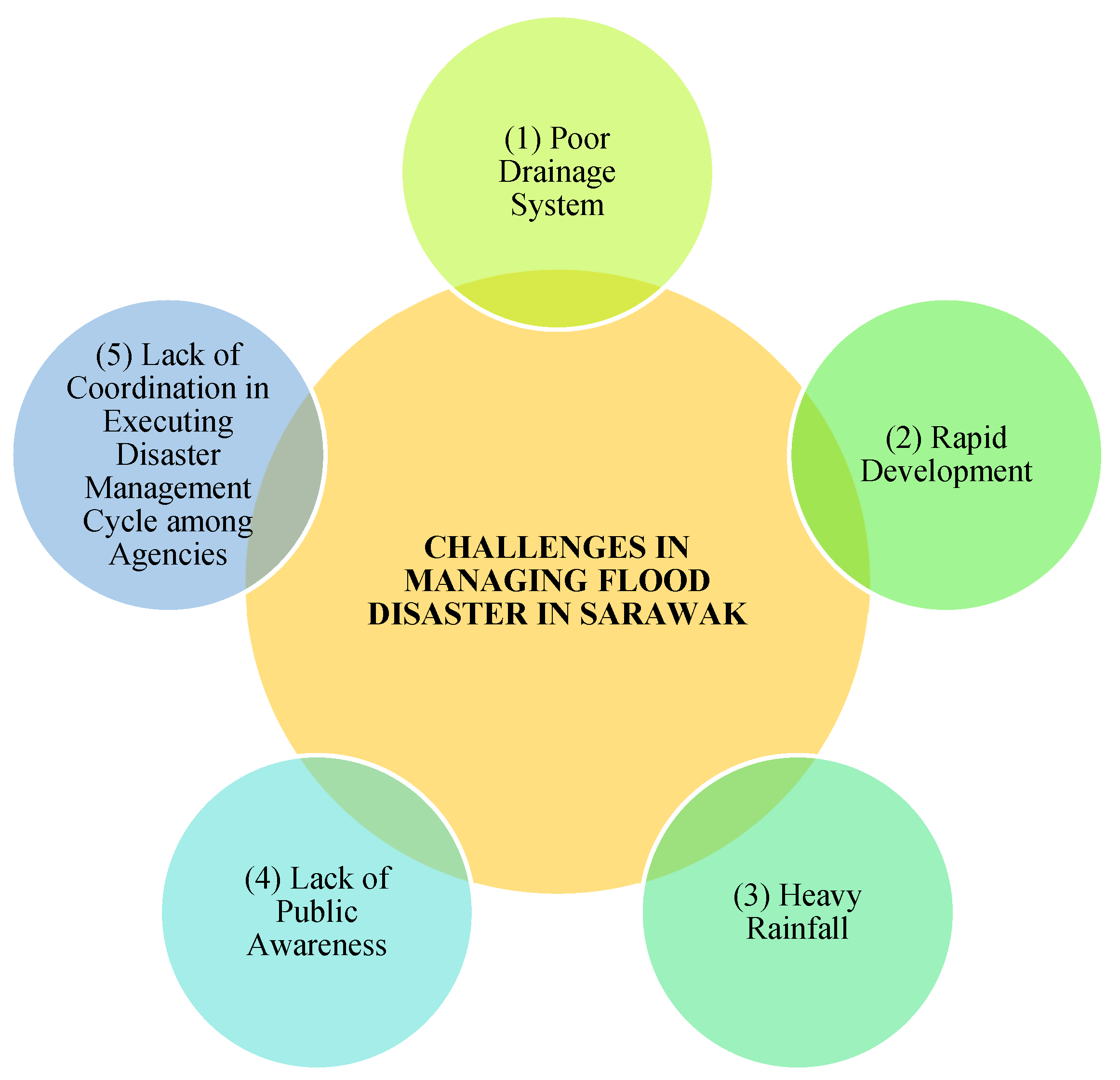

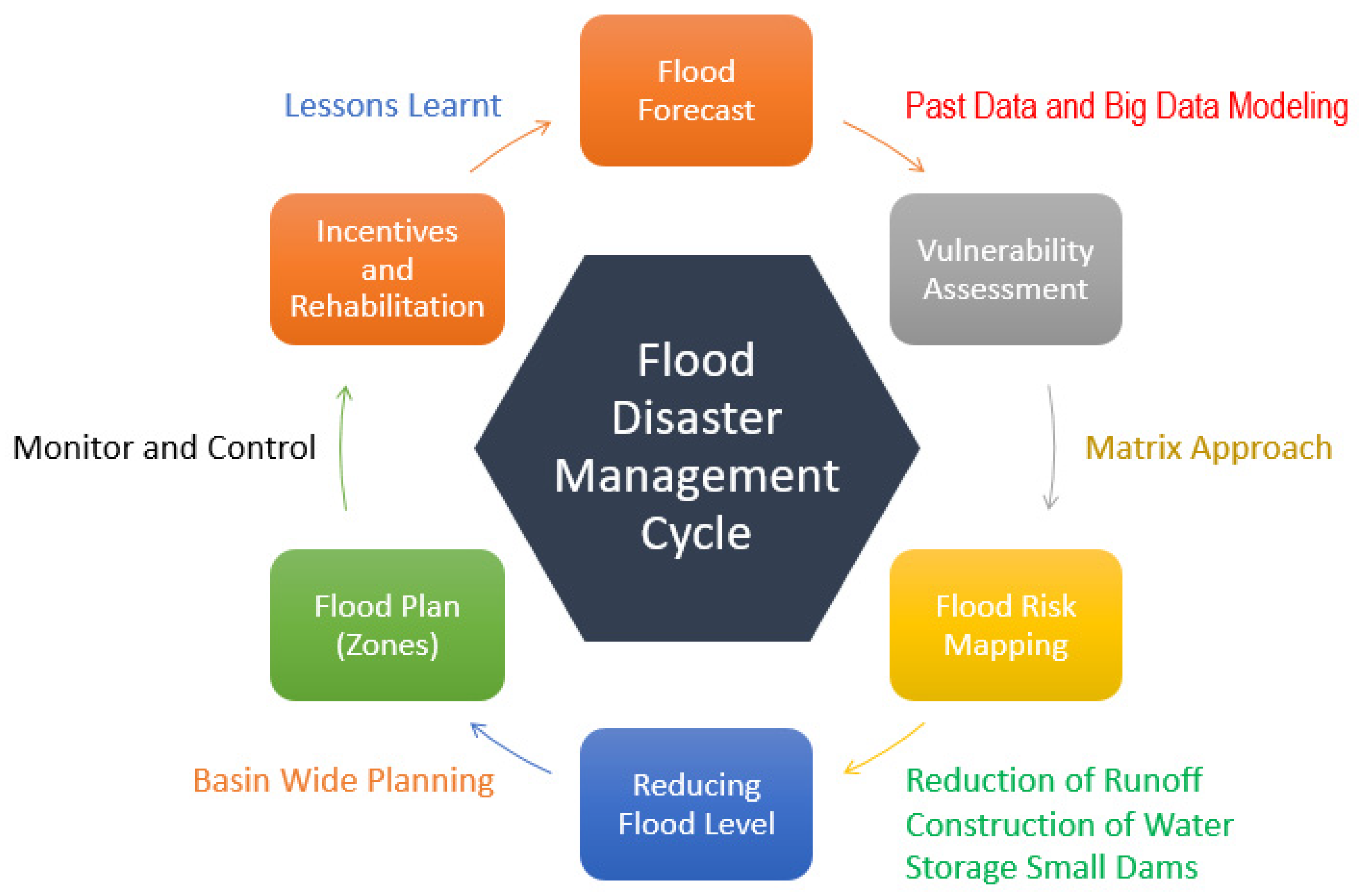
| Market Inventory | Non-Market Inventory | |
|---|---|---|
| Direct | Effect of floodwaters on financial resources, example:
| Effect of floodwaters causing, example:
|
| Indirect | Cultural effects outside of the flood zone (existence), example:
| Cultural effects outside of the flood zone (existence), example:
|
| No. | Author | Source Title | Challenges Highlighted |
|---|---|---|---|
| 1 | Chong & Kamarudin (2018) [32] | Disaster risk management in Malaysia: Issues and challenges from the perspective of agencies |
|
| 2 | Yazid et al. (2017) [40] | Flood Risk Mitigation: Pressing Issues and Challenges |
|
| 3 | Al-Dahash et al. (2016) [41] | Challenges during Disaster Response Planning Resulting from War Operations and Terrorism in Iraq |
|
| 4 | Rubinato et al. (2019) [42] | Urban and river flooding: Comparison of flood risk management approaches in the UK and China and an assessment of future knowledge needs |
|
| 5 | Shah, Rahman, & Chowdhury (2018) [42] | Challenges for Achieving Sustainable Flood Risk Management |
|
| 6 | Mabahwi & Nakamura (2020) [44] | The Issues and Challenges of Flood-related Agencies in Malaysia |
|
| 7 | Ali et al. (2019) [45] | Challenges for flood risk management in flood-prone Sirajganj region of Bangladesh |
|
| 8 | See, Nayan, & Rahaman (2017) [46] | Flood Disaster Water Supply: A Review of Issues and Challenges in Malaysia |
|
| 9 | Waylen et al. (2018) [47] | Challenges to enabling and implementing natural flood management in Scotland |
|
| 10 | Nurashikin, Rodger, & Rumaizah (2019) [48] | Reducing Flooding Impacts to the Built Environment: A Literature Review |
|
| No. | Author | Source Title | Mitigations Reported |
|---|---|---|---|
| 1 | Mohamad Yusoff et al. (2018) [54] | Exploring the managing flood disaster: A Malaysian perspective |
|
| 2 | Ramanuja (2015) [49] | Challenges in Disaster Management |
|
| 3 | Khalid & Shafiai (2015) [50] | Flood Disaster Management in Malaysia: An Evaluation of the Effectiveness Flood Delivery System |
|
| 4 | Ogie, Adam, Perez (2020) [55] | A review of the structural approach to flood management in coastal megacities of developing nations: current research and future directions |
|
| 5 | Yang & Liu (2020) [51] | A General Overview of the Risk-Reduction Strategies for Floods and Droughts |
|
| 6 | Sulaiman et al. (2019) [56] | Multi-Agency Collaboration in Flood Disaster Management in Sarawak, Malaysia |
|
| 7 | Jongman (2018) [57] | Effective adaptation to rising flood risk |
|
| 8 | Hapsari & Zenurianto (2016) [52] | View of Flood Disaster Management in Indonesia and the Key Solutions |
|
| 9 | Rehman et al. (2019) [53] | Applying systems thinking to flood disaster management for a sustainable development |
|
| 10 | Raikes et al. (2019) [54] | Pre-disaster planning and preparedness for floods and droughts: A systematic review |
|
| No. | Year | Newspaper Title | Challenges in Managing Flood Disaster in Sarawak | Solutions in Managing Flood Disaster in Sarawak | Source | Reference Link |
|---|---|---|---|---|---|---|
| 1 | 2019 | Managing Flood Problems |
|
| New Straits Times (NST) | https://www.nst.com.my/opinion/columnists/2019/10/532457/managing-flood-problems (accessed on 11 February 2022) |
| 2 | 2019 | Sarawak prepares for floods as two river basins register daily rainfall above 100 mm |
|
| The Star | https://www.thestar.com.my/news/nation/2019/11/14/sarawak-prepares-for-floods-as-two-river-basins-register-daily-rainfall-above-100mm (accessed on 11 February 2022) |
| 3 | 2019 | Over 1000 people affected as floods cause damage in Sarawak |
|
| The Straits Times | https://www.straitstimes.com/asia/se-asia/over-1000-people-affected-as-floods-cause-damage-in-sarawak (accessed on 11 February 2022) |
| 4 | 2018 | New approach in overcoming flash flooding in Sarawak |
|
| The Borneo Post | https://www.theborneopost.com/2018/07/17/dr-sim-new-approach-in-overcoming-flash-flooding-in-sarawak/ (accessed on 11 February 2022) |
| 5 | 2018 | Northern Sarawak put on flood alert after rivers breach danger level |
|
| The Star | https://www.thestar.com.my/news/nation/2018/11/07/northern-sarawak-put-on-flood-alert-after-rivers-breach-danger-level/ (accessed on 11 February 2022) |
| 6 | 2018 | Crocodiles and snakes are among the challenges faced during flood relief efforts |
|
| New Straits Times (NST) | https://www.nst.com.my/news/nation/2018/02/334509/crocodiles-and-snakes-among-challenges-faced-during-flood-relief-efforts (accessed on 15 February 2022) |
| 7 | 2018 | Malaysia-Thousands Evacuated After Floods in Sarawak State |
|
| Flood List | http://floodlist.com/asia/malaysia-sarawak-february-2018 (accessed on 15 February 2022) |
| 8 | 2017 | Flood risk in parts of Sarawak |
|
| New Straits Times (NST) | https://www.nst.com.my/news/nation/2017/11/302927/flood-risk-parts-sarawak (accessed on 15 February 2022) |
| 9 | 2017 | ‘Kuching may adopt Hiigate City’s example to solve flood woes.’ |
|
| The Borneo Post | https://www.theborneopost.com/2017/02/24/kuching-may-adopt-hiigata-citys-example-to-solve-flood-woes/ (accessed on 15 February 2022) |
| 10 | 2017 | State steps up flood mitigation effort |
|
| The Star | https://www.thestar.com.my/metro/community/2017/01/09/state-steps-up-flood-mitigation-effort-sarawak-may-seek-foreign-expertise-to-find-best-solution (accessed on 15 February 2022) |
| 11 | 2017 | Government revs up preparation to face the possibility of a major flood in November |
|
| New Straits Times (NST) | https://www.nst.com.my/news/nation/2017/10/288787/government-revs-preparation-face-possibility-major-floods-november (accessed on 16 February 2022) |
| 12 | 2016 | Poor drainage led to flooding |
|
| The Star | https://www.thestar.com.my/metro/community/2016/06/21/poor-drainage-led-to-flooding-floods-in-february-and-may-were-storm-water-related-says-state-governm (accessed on 16 February 2022) |
| 13 | 2016 | Floods wreak havoc in Sarawak |
|
| The Star | https://www.thestar.com.my/news/nation/2016/02/28/floods-wreak-havoc-in-sarawak (accessed on 16 February 2022) |
| 14 | 2015 | Long-term solution needed to turn the tide |
|
| The Borneo Post | https://www.theborneopost.com/2015/02/01/long-term-solution-needed-to-turn-the-tide/ (accessed on 16 February 2022) |
| 15 | 2015 | New Disaster Unit to be set up soon |
|
| The Borneo Post | https://www.theborneopost.com/2015/01/24/rohani-new-disaster-unit-to-be-set-up-soon-says-rohani/ (accessed on 16 February 2022) |
Publisher’s Note: MDPI stays neutral with regard to jurisdictional claims in published maps and institutional affiliations. |
© 2022 by the authors. Licensee MDPI, Basel, Switzerland. This article is an open access article distributed under the terms and conditions of the Creative Commons Attribution (CC BY) license (https://creativecommons.org/licenses/by/4.0/).
Share and Cite
Muzamil, S.A.H.B.S.; Zainun, N.Y.; Ajman, N.N.; Sulaiman, N.; Khahro, S.H.; Rohani, M.M.; Mohd, S.M.B.; Ahmad, H. Proposed Framework for the Flood Disaster Management Cycle in Malaysia. Sustainability 2022, 14, 4088. https://doi.org/10.3390/su14074088
Muzamil SAHBS, Zainun NY, Ajman NN, Sulaiman N, Khahro SH, Rohani MM, Mohd SMB, Ahmad H. Proposed Framework for the Flood Disaster Management Cycle in Malaysia. Sustainability. 2022; 14(7):4088. https://doi.org/10.3390/su14074088
Chicago/Turabian StyleMuzamil, Syed Ahmad Hakim Bin Syed, Noor Yasmin Zainun, Nadiatul Nazleen Ajman, Noralfishah Sulaiman, Shabir Hussain Khahro, Munzilah Md. Rohani, Saifullizan Mohd Bukari Mohd, and Hilton Ahmad. 2022. "Proposed Framework for the Flood Disaster Management Cycle in Malaysia" Sustainability 14, no. 7: 4088. https://doi.org/10.3390/su14074088
APA StyleMuzamil, S. A. H. B. S., Zainun, N. Y., Ajman, N. N., Sulaiman, N., Khahro, S. H., Rohani, M. M., Mohd, S. M. B., & Ahmad, H. (2022). Proposed Framework for the Flood Disaster Management Cycle in Malaysia. Sustainability, 14(7), 4088. https://doi.org/10.3390/su14074088







